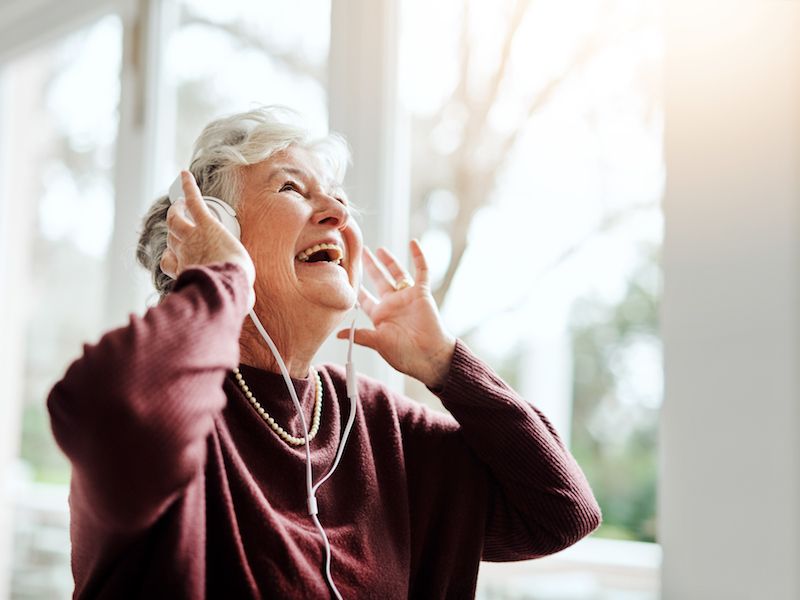
Noise-related hearing loss doesn’t just affect individuals who work in loud surroundings, such as construction workers or heavy metal roadies. Leisure associated noise exposure can be just as damaging as work related noise exposure. The most common type? Loud sounds heard through headphones, whether it’s music, gaming, streaming video, or even an audiobook with the volume cranked up.
You may be alarmed to discover that a mobile device can go that loud. The typical pain threshold for human hearing is around 150 db which is in the range of these devices. This is the volume at which noise starts to literally hurt your ears. So what can you do to safeguard against this sort of noise-related hearing loss?
It’s important here to consider the volume. A quick shorthand that’s widely recommended is the 60/60 rule: Listen with the volume at no more than 60% for no more than 60 minutes at a stretch (because how long you listen for matters, too).
Your Hearing Aids Can be Set up For Listening to Music
If you have hearing aids, you’re likely streaming your device right to your hearing aids, so be certain the volume is not too loud or that you’re not trying to drown out other noises with your music. In addition, ask us about how best to listen to music. Hearing aids aren’t created to increase the quality of music like they do with voices so if you’re really into music, you may have discovered this. While enjoying music, we can probably make some modifications to help improve the sound quality and lessen the feedback.
What Are The Right Headphones For You?
When purchasing headphones there are numerous options, particularly if you wear hearing aids. There are various things to consider, although it’s generally a matter of personal choice.
Over-the-Ear Headphones
While the foam-covered speakers that came with your old Walkman are basically no longer used, over-the-ear headphones have had a resurgence. They have lots of choices in style and color, are commonly endorsed by celebrities, and can be surprisingly costly. And these headphones cover the entire ear blocking out noise, unlike those old foam ones.
Conventional perception is that these are less dangerous than in-ear headphones because the source of the sound is further from your eardrum. But the fact is they’re often able to reach louder volume than the smaller kind, the speakers are much larger. Also, noise-canceling could possibly help you ignore the crying baby on your flight, but in other circumstances, it can block sounds you need to hear (like a car honking). That said, because they cancel out outside sound, you can normally decrease the volume of what you’re listening to so it’s not so loud that it will cause damage to your hearing.
Earbuds
The normal earbuds are well known for inferior sound quality, yet lots of people still use them because hey, they came with the phone. Particularly, with newer Apple devices, it’s simply easier to use the earbuds that came with the device because it probably doesn’t have a headphone jack.
Earbuds also don’t cancel out noise so the downside is, you tend to turn up the sound level. Again, though it’s commonly said that earbuds are problematic because you put them into your ear so their speakers are extremely close to your eardrum, volume is really the biggest issue.
Earbuds That Block Outside Sound
A lot of people buy earbuds with a rounded, rubbery tip both because they’re more comfy than standard earbuds and more effective at stopping outside noises. A seal that blocks outside sound from entering is formed by the rubber tip which conforms to the shape of the ear. But these earbuds can also block out noises you might need to hear and volume is still the main concern. And if you use hearing aids, clearly these won’t work for you.
A number of pairs may need to be tested before you find headphones that are appropriate for you. Depending on what you regularly use them for talking on the phone, say, versus listening to music, you’ll have unique acoustic expectations. The relevant thing is to seek out headphones that make it comfortable for you to enjoy at a safe sound level.
Don’t Cut Corners When it Comes to Your Hearing
How can you be sure it’s safe? If you use a smartphone, you can get an app for that, you can download the National Institute for Occupational Safety and Health’s free Sound Level Meter app. There are different apps out there, but research has discovered that the reliability of these other apps is spotty (in addition, for unknown reasons, Android-based apps have been shown less reliable). That prompted NIOSH to create an app of their own. The app allows you to measure outside sounds, but it’s also possible to measure the sound coming from your device’s speakers, in other words, the actual volume of what’s being sent to your ears. It’s a little bit of work, but taking these kinds of protective steps can help protect your ears.